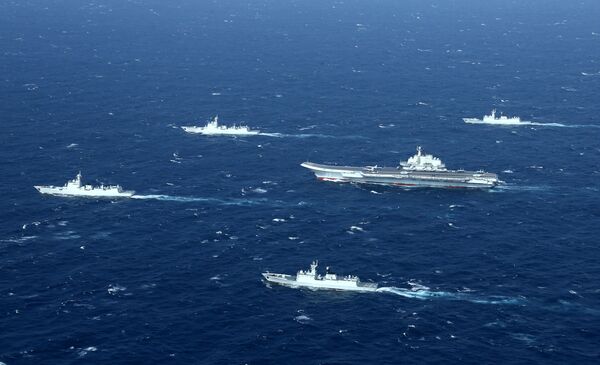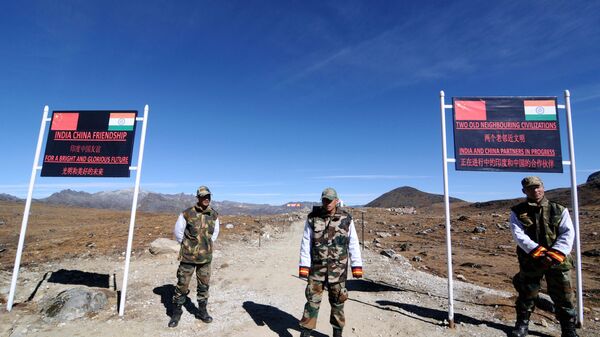On 20 May, Alice Wells, a US ambassador, spoke at an online conference at the Atlantic Council, one of America's leading think tanks, regarding the border standoff between India and China.
Talking to Rish Verma, the US Ambassador to India from 2014-2017, she drew parallels between the confrontation in the Himalayas and the situation regarding the disputed South China Sea.
The diplomat called China's actions on the border with India, as well as in the South China Sea, "constant aggression", "constant attempts" to change existing norms and the status quo, Business Insider India cited her as saying.
She then called to counter China, both in the South China Sea and on India's land and sea borders, while adding that the increased presence of the Chinese military on the border, where temporary clashes are quite common, has caused concern on the Indian side. According to her, the issue is becoming more acute in light of Beijing's efforts to "evade responsibility and spread misinformation".

Many analysts believe that the United States has always been interested in maintaining tensions between India and China. This is one of the tools to implement their Indo-Pacific strategy, aimed, among other things, at strengthening the country's influence in South Asia, Andrei Volodin, an IMEMO RAS expert, professor at the Diplomatic Academy of the Russian Foreign Ministry, pointed out:
"The statement (by the American ambassador) is just one example. Moreover, this statement obviously fits into the Trump administration's current general strategy to discredit China as the 'source' of the coronavirus pandemic. The US, which is conducting an anti-Chinese campaign, is now trying to involve the maximum number of not only their satellites in Western Europe, but also the maximum number of Asian states. Asian countries, in general, react quite neutrally to these attempts".
At the same time, the expert ruled out the possibility that US support for India in the border conflict with China could provoke it to take unilateral action. In the context of the epidemiological crisis, even the Indian military believes that it's necessary to focus as much as possible on the economy and development.
They are ready to come to terms with the fact that Prime Minister Narendra Modi is redistributing forces and assets in favour of the civilian sector.
"In addition, the experience of the 1962 war and subsequent conflicts between China and India is not in India's favour", Andrei Volodin said.
China's restraint and its ability to achieve mutual understanding with India frustrate Washington's strategic goal of them coming into conflict, as Delhi appreciates its independence and is unlikely to want Washington to use it as a tool to contain Beijing, Wang Peng from the People's University of China said, commenting on the US diplomat's statements:
"The Indo-Pacific Strategy is the key strategy among the Trump administration's global foreign policy aims. In June 2017, there was a standoff between China and India in Doklam, and in November of the same year, the United States introduced the concept of the Indo-Pacific Strategy at the APEC meeting in Vietnam. There were only a few months between those events. It is no coincidence that many analysts believe that the Sino-Indian confrontation could have affected the development of Trump's strategy. The US has never stopped trying to form a political 'square' consisting of the United States, Japan, India, and Australia to deter China".

"Meanwhile, China maintains restraint and seeks mutual understanding with the Indian side; therefore the United States cannot achieve its strategic goals. The Trump administration relies heavily on provoking disputes and increased tension between certain countries and China to achieve its own goals, which allows the United States to make these countries even more strategically dependent. However, the problem is that the US strategy is contrary to India's national interests and cultural traditions. India really appreciates its independence and doesn't want to be used as a tool".
The provocative nature of Alice Well's statement is obvious given the difficult situation in the northwest section of the Line of Actual Control between China and India. In fact, her words can even be regarded as US support for India's territorial claims against China, which could make the situation on the Sino-Indian border even more explosive. This month there have already been two, albeit minor, clashes involving dozens of military personnel from both sides.
Additional defensive structures are also being constructed on both sides of the Line of Actual Control in Ladakh, which also increases the tension. The other day, the Chinese military reported that India had built fortifications to deliberately foment conflict and unilaterally modify the existing border control system. The Global Times reported, citing a source in the PLA, that it had successfully restored the status quo in the Galwan Valley.
For its part, the Indian Express reported on 20 May that tensions along the Sino-Indian border in Ladakh near lake Pangong Tso had increased. According to the Indian newspaper, the Chinese military had tripled the number of patrol boats in the area to match the number of Indian craft in the waters off the western shore of the lake.




